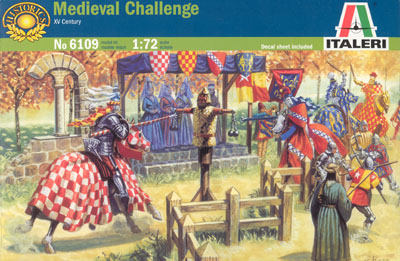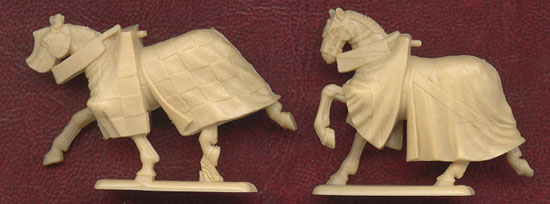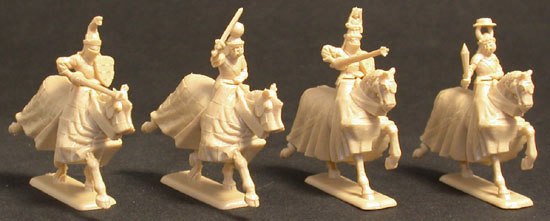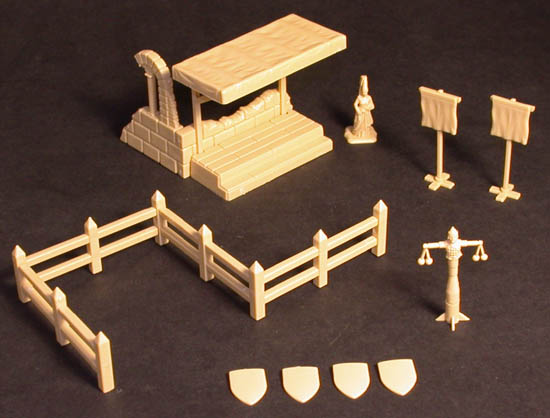
This set appeared some time after the tournament set and shares many of the same components, but with some new ones too. Gone are the sets of English and French fighting men, along with the paraphernalia of the joust such as the grandstand and fencing. Instead we get some new accessories, which are perhaps intended to show a knight in training, although we think this should really be seen as merely an extension of the tournament set.
To begin with however, these are the components that were also in the tournament set. There are some knights on horseback, including some clearly intended for the clash of lances. These are below.


There are four of them, and all are very different, including splendid crests. However in an unusual move Italeri sculpted their legs with the horse, and so, as can be seen, they made the torsos plug onto the legs, which allowed the legs to be underneath the caparison. This creates a somewhat different but very effective finished model, as illustrated here...

Moving on from the new knights, there is little point in jousting unless there is someone there to appreciate your achievements, and this set has a number of other figures, including dismounted knights, tournament officials and spectators. Here are the pictures:



All are really nice, although at an average of 25 to 26mm in height for the men they are too tall for the advertised scale. Still they remain some of the best non-fighting medieval figures yet made in this scale.
The unique elements to this set are pictured below:

Perhaps the main item is the shelter, set into what seems like part of a ruined building. Why a tournament might be held amongst ruins we do not know, but the construction, which only slightly resembles a medieval bus stop, is supported by the ruined walls as shown. A much simpler affair than the grandstand in the tournament set, but perfectly reasonable nevertheless.
The fencing comes in four identical sections which slot together as shown (plus an extra end post). This arrangement is the only one possible with these pieces, although by drilling or trimming the enterprising modeller could force something different if desired.
On the right can be seen a couple of nice banners and in front of them a quintain. A quintain could come in various forms but the basic principle was that a knight struck a target (usually a shield) which caused the device to swivel, bashing the knight with a heavy object if he did not ride fast enough to get out of the way. The sculptor of this one has clearly seen an illustration, and knows that they often took the form of a 'saracen', but has completely misunderstood the purpose of the device and has given it sand filled bags on both arms, making it completely useless. Surely Italeri could have managed to explain the purpose of this device, but they did not and the result is a ridiculous and useless object.
In front of the quintain are a number of shields which the instructions tell us could be used to decorate the roof of the shelter. While they are much too large as normal shields perhaps one could be used to make the quintain something useful instead!
Finally there are a small number of wet-transfer decals of basic heraldic devices to decorate the shields and banners.
The parts are crisply done and fit reasonably well. Had it been done properly the quintain would have been the most useful item in this box, but as it is everything else is of some value. Our photo includes one of the over-sized lady figures to give an impression of relative size, although none of the new components are size-critical. To our mind this is something of a poor cousin to the tournament set because the array of accessories is more meagre, though the figures are great whichever set you buy. Some strange design decisions mar what would otherwise have been a lovely set, but everything is well made, and there is still plenty here to appeal to fans of the period.